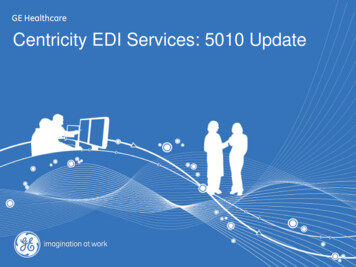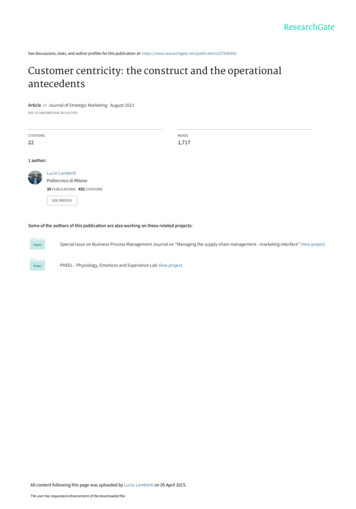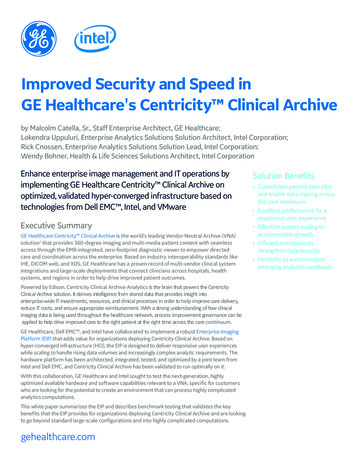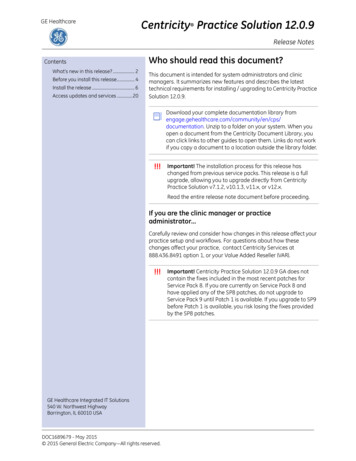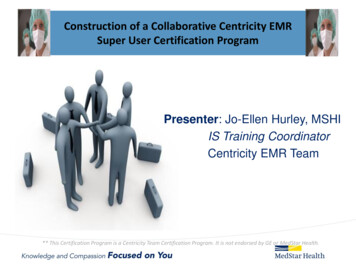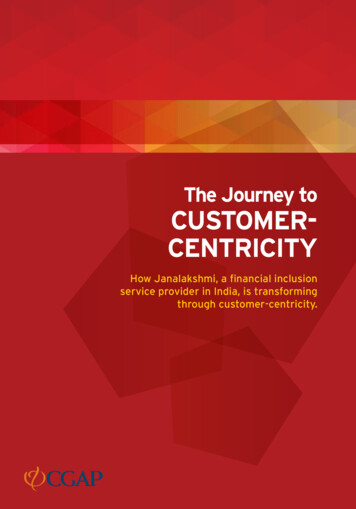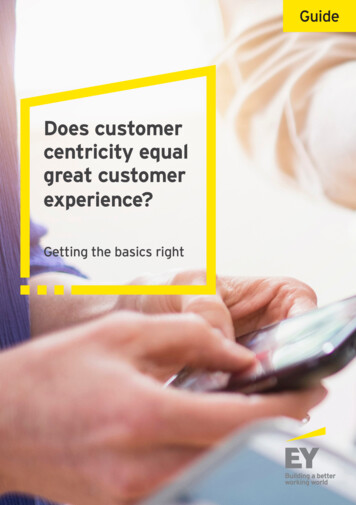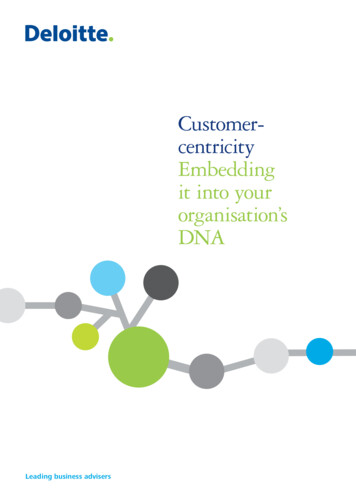
Transcription
CustomercentricityEmbeddingit into yourorganisation’sDNALeading business advisers
Contents2Foreword3Introduction41. Visible, customer-focused leadership52. Understand your customer63. Design the experience74. Empower the frontline95. Engage the back office106. Metrics that matter117. Feedback drives continuous improvement128. Tangible actions13Conclusion16Contact us17
ForewordCustomer expectations and behaviours have changed dramaticallyover the past decade. Organisations are expected to meet customers’needs and expectations at every interaction, in return for customerloyalty. The ability to deliver this depends on the extent to which‘customer-centricity’ is embedded within every single person in yourbusiness.Few organisations have the necessary organisational culture to deliver truly customer-centriccustomer experiences. Often, a well-intentioned strategy is diluted by operational constraints(whether real or perceived) and a loss of focus, resulting in little more than lip-service beingpaid to the concept of customer-centricity.Too many organisations focus on trying to deliver ‘world class’ service – rather than givingcustomers what they actually want, which in most cases is a quick and easy process to follow,that is right first time. There is a disconnect between strategy and vision, and the operational staff and thebehaviours that are required to really deliver the customer experience. In our experience, thisis usually caused by siloed business units, misaligned reward and recognition packages, and alack of executive buy-in. Regulatory or other enforced processes are used as an excuse to provide poor customerexperiences without considering other experience based principles that can be used tomanage and improve the customer experience. Traditional customer feedback is often reviewed days and weeks following the actual event.Digital and online social platforms such as Twitter, Facebook and Blogs are enabling massfeedback to be captured in real-time, and distributed across the business to those responsibleto action immediately. Often, non customer-facing business units form the greatest obstacle in preventing acompany from becoming truly customer-centric. Organisations often over-focus on thefrontline service delivery teams, and do not focus on creating the required mindsets,behaviours and processes, within the back and head-office teams.The focus over the last number of years has been on cost reduction and consolidation. Nowthat the growth agenda is firmly back on the table the time has come to refocus and ensurethat the customer takes centre stage once again. Our team has worked with clients across arange of customer issues in particular customer experience, customer insight and customerservice transformation and we are happy to talk with you to explore the issues further.The enclosed thought leadership piece was authored by my colleague, Scott Wheatley, apartner in our UK practice and Chair of the Customer Service Leaders forum.Yours sincerely,Cormac HughesPartner,Strategy & OperationsDeloitte Dublin3
IntroductionFor today’s organisations, becoming morecustomer-centric isn’t just a feel-good mantra, it’s acore business requirement. Whether the challengeis increased regulatory pressure, consolidation,cost pressures, rapidly shifting consumer trends– or, more likely, all of the above – a customercentric focus can play an instrumental role instaying a step ahead of the competition. It canhelp grow revenues, improve efficiency, and driveperformance. If it is embedded in your organisationit can also lead to sustainable profitability. Fromour experience, we have distilled seven areas toconsider when embedding the customer at theheart of your organisation:Lead from the top with a customer focusedapproach. Embedding the customer at the heartof your operations needs to start with the seniormanagement using their leadership to drive thecustomer focus within their teams.Understand your customers. Customer profiledata allows organisations to gain deep insightinto the varying needs of their different customersegments. Analysis of the mix of backgrounds,preferences and spending habits allows you to tailorproduct and service requirements for each segment.Design the experience. It is crucial to understandwhat the customer’s journey looks like across theproduct lifecycle. This alternative view of yourbusiness processes allows you to empower yourpeople who are serving customers at each of thekey touch points along the journey.Empower the frontline. Our clients understandthat many decisions, whether they are queries orcomplaints from customers, require immediateconsideration in order to be resolved promptly.Removing the need to escalate decision making andempowering the frontline to make decisions willserve to improve the spectator experience at thepoint issues arise.Engage the supporting operations. It is not justfrontline staff or the leadership team that need tobe customer focused, support functions such asProcurement, IT, HR and Finance own processesand relationships that directly impact the customerand it is important they adopt a customer-centricapproach in carrying out their duties.Encourage the right behaviours. Motivated andempowered staff will go that extra mile to ensurethat customers are satisfied, particularly during thekey ‘moments of truth’ in the customer relationship.Use customer feedback to drive real-timeimprovements. Twitter, Blogging and Facebookare now mainstream channels where everybodyhas something to say. Leading edge customerfocused organisations have gone to great lengthsto define a customer insight and feedback strategythat allows them to identify and prioritise customerfeedback from social media channels within hours.This will allow feedback to be passed to managersat the start of each day to allow them to makeoperational changes in near real-time.Fig.1. Strategies for embedding customer-centricity into your organisation43Empowerthe frontlineMetricsthatmatterDesign stomerfocusedleadership45Engage theback officePuttingcustomercentricity atthe core ofyour business7Feedbackdrivescontinuousimprovements
1. Visible, customer-focused leadershipYou cannot be customer-centric if the customer experience is not an executivepriorityAccountable customer-focused leadership.Having clear leadership from the top that articulateswhat customer-centricity means to your business,and what it looks like in practice, is critical tocreating a customer-centric organisation. Whilst itis common to have someone responsible for thecustomer experience, organisations that are trulyfocused on building their business around theircustomers are empowering top executives to ownthe customer journey, from initial contact throughto final resolution.This means that individuals need to be accountablefor customer experience at key touch pointswithin the customer lifecycle. A key challengethat many organisations face is how to changeservice accountability from product driven orsilo based views of the customer, and move thecustomer service function towards common,experience based indicators. Enabling this change isfundamental to driving the right behaviours.A number of organisations such as Oracle, havedeveloped Chief Customer Officer (CCO) roles atsenior levels to help facilitate and drive some ofthese changes. The CCO role is typically responsiblefor providing a single vision across all methodsof customer contact and is often responsible forinfluencing business units both in the front andback office with the purpose of promoting thecustomers agenda. It is common for these rolesto report the Chief Executive Officer (CEO) and inmany instances the CCO is a member of the board.Governance and common purposeSuccessful Customer Service Leaders throughoutthe organisation must also have the ability to buildstrong relationships with key areas of the businessthat impact the customer experience. Often thismeans playing the role of peacemaker and teacher,to educate other business functions, such as ITand HR, about the impact that changes in otherbusiness functions have on the customer. High-levelgovernance and lower level, cross-function workinggroups and relationships are fundamental to drivingpositive customer experiences. Often startingwith new projects, success will come throughembedding these behaviours into ongoing dailyactivities.New ways of communicatingAs customers have changed the way they interactwith organisations and moved towards digitalchannels (Facebook, Twitter, Blogs etc.) It isessential that customer service leaders are seen tohave a voice and presence through these digitalchannels. The ability to communicate and engagevia short and direct messages is a powerful toolthat allow customers and employees to keep upto date without having to spend large amounts oftime searching, reading documents or listening topresentations.Steve Jobs regularly used You Tube to make specialannouncements to Apple staff and customers,proving far more successful and engaging thanthe traditional methods such as mass email, bycreating a more personal approach.Some organisations have built large socialnetworks that allow employees to communicateand engage with each other via digitalchannels allowing real- time engagement andcommunication not possible in traditionalchannels. An emerging trend we are seeing isCEOs and other senior executives taking the timeto respond personally to customer complaints andfeedback via these same digital channels.Leading edgeSome organisations are implementing customerrooms, a customer centric space where thecustomer experience is brought to life. Keyexperience touch points are highlighted aroundthe walls of the room, including actual examplesof the services the customer experiences. The ideais to draw out opportunities to create a betteroutcome for the customer by having a clear viewof customer feedback and complaints insightsalong with the key metrics.Last but not leastSome of the more traditional and informalmethods of communication are often over looked.‘Water-cooler’ conversations whereby seniorexecutives relay real stories of employees deliveringexceptional customer service, are a simple yetextremely effective way to show awareness fromthe top of what’s happening and the frontline.These scenarios can provide motivation andinspiration for employees to provide the same levelof service.5
2. Understand your customerUnderstand who your customers are and their likely behaviours to tailorexperience based on what you know about themTransformational changeCustomer Insight Teams and Voice of the Customer(VoC) Programmes are becoming an integral partof all customer experience initiatives. They aredriven from all areas of the organisation to betterunderstand the customer. Many organisationsreport positive results, albeit incremental, ratherthan transformational change. In order to fullycapitalise on these programmes companies needto leverage their data/insights to drive decisionmaking.Connect internal and external customer data Someorganisations combine behaviour and usage datawith external customer information, providinga view of customers based on behaviour and usage.This identifies opportunities that are not alwaysrevealed through traditional methods. Externalinformation from a customer’s background providesa valid insight into their spending profile and habits.Analysis can often lead to breakthroughs inthe services and products you choose to offercustomers and how you choose to interact withthem.Looking through the right lensCustomers can be viewed, grouped and organisedin all sorts of ways depending on the approach. Forexample, whether considered as an individual or afamily can drastically alter the results. For anorganisation to achieve the outcome best suitedto them, the approach they take to identifyingtheir customers is crucial. The approach shouldbe monitored and adapted in line with anorganisation’s customer service strategy to providedifferent views of the customer base.Look for variationsMany organisations lack depth in their customerinsight. The ability to identify variances in customerprofiles unlocks a wealth of information with whichto target them. Understanding the different socioeconomic groups, location of origin, address andhousehold details can help organisations approachcustomer service in a way that is much more usefulto the customer. For example, an individualtravelling to an Olympic venue from Greater Londonis going to need very different transport informationto one who is travelling from rural Scotland.Sending customers a tailored travel plan basedon their profile is far more useful than sending ageneric one.Pass it onAbove all, it is vital to communicate these insightsacross the organisation, especially to areas thattypically would not consider customer insight aspart of both operational and strategic change.6VOC programmes are driven fromall areas of the organisation tobetter understand the customer
3. Design the experienceThe perception of the experience is what mattersThe customer perception of a brand is basedon what they see, hear and sense. These initialimpressions need to be backed by empoweredemployees and business processes that minimisecustomer effort. This perception often startswith the brand. The brand is the essence of theunderlying perception that your customers haveof an organisation. Often there is a significantdisconnect of the delivery of this brand betweenSales and Marketing and Customer Care.Defined customer experiencePart of embedding the brand, and key to managingcustomer expectations is having a defined endto-end customer experience. This enables the keyinteraction touch-points across every channel to beidentified and understood. Key to understandingthese touch-points is taking a holistic approach andincorporating every aspect involved. For LOCOGas part of London 2012 this was consideringdetails down to the quality of the toilets againstcustomer expectations. Once these touch-pointsare understood, they can be designed to specifyexactly what you want the customer to perceiveat each touch-point. Often this means creatingcost- effective processes where the customer mayperceive a seamless experience, but which may relyon manual processes to fulfil it.This process should also encompass emerging digitaland mobile customer interaction channels such asFacebook, Twitter and smartphone applications. Thechange in how consumers are choosing to interactwith organisations and the speed at which it ishappening, has established these types of contactchannels as real channels that customers expectorganisations to be able to interact with them on.Many organisations fail to do this in a clear andconcise manner.Moments of truthThe majority of customers do not want amazingservice, instead they want clear and accurateinformation on the service they will receive.Customers simply want an efficient, friendlyexperience that resolves their enquiry. However,there are key moments in a customer’s lifecyclewhere delivery of outstanding service will influencetheir long-term perceptions and behaviours(otherwise known as ‘moments of truth’). One wayorganisations are achieving this is through changingthe behaviour of employees around a limitednumber of key customer interaction touch pointsthat are most critical to providing competitivedifferentiation. Through targeting people centricchange at key events, specific behaviours andactions can be identified and then taught andcommunicated to employees who are responsiblefor delivering it.Service promisesSuccessful customer-centric organisations also tendto have service promises or customer charters,which outline what customers can expect. Eachpromise needs a clear metric to measure againstand senior executives must be accountablefor delivery of them across the organisation.Organisations need to create events and themesaround these promises to keep them relevant,refreshed and top-of-mind. A pertinent examplehere is that of Zappos (a US online shoe retailer).Zappos is renowned for its customer service loyalty.They have ten values which are embedded ininduction and regular training. Each month a valueis celebrated across the business.The customer perception of abrand is based on what they see,hear and sense.7
Figure 2. Planning customer interactions across the lifecyclePROSPECTNEW CUSTOMERACTIVEAT RISKAttempt re-signcontractValue of customerStart contract renewal processCall in to cancel productUpgrade existing packageReceive up-sell communications and offersManage profile updatesReceive cross-sell communications and offersSubmit and track service issue or complaintReceive billView transaction history, service usage and invoicesTrack order statusSend welcome pack/callBuy product(s) and/or servicesReceive inbound marketing responseMake out bound prospect contactBrowse products and servicesCustomer led interactionBusiness led interactionEach service promise needs a clearmetric to be measured by, and seniorexecutives must be accountable fortheir delivery across the win-backoffers
4. Empower the frontlineEmpower the frontline to make decisions when it countsThe foundation for great serviceTo empower the frontline, the brand and itsimplications need to be understood. Providingempowerment to the frontline works best whenpeople believe they are an important part of theorganisation. Senior management need to regularlyshow their appreciation of the role people play onthe frontline and acknowledge the feedback theyprovide as well as leading by example. It is thefrontline staff who understand better than mostthe impact that specific changes will have on boththeir roles and on the customer. Ensuring that yourfrontline team understands how you want to treatcustomers and the style of relationship you wantyour customers to experience will impact howthey behave, the sorts of decisions they make andultimately will form the view that the customer hasof the organisation.The right toolsThere are a number of key factors to consider whenembedding customer-centricity into operations.Giving power to frontline colleagues is essential;they need to have the ‘right’ tools and informationto help them meet customer needs. There needsto be clear decision making channels to enablefrontline staff to make ‘on-the-fly decisions’ thathelp resolve queries at first point of contact.Traditionally, processes have been built aroundscripts and measurement frameworks that aredesigned to deliver conformity. However, experiencehas told us that this can lead to unhappy customerswhen their needs do not fit the script. Someorganisations have gone to the other extreme andprovide ambiguous or unclear frameworks whichincrease the risk factor, particularly around customeridentification and verification processes.Single Customer ViewOne of the single, biggest things that organisationscan do to empower the frontline is provide a SingleCustomer View (SCV) of all customer interactions,relationships and external activity. We haveidentified four dimensions of the SCV in Figure 3.Whilst the ‘4D’ view may be seen as utopian bymany organisations, it is essential that a realisticroadmap is built to show how the SCV continuouslyevolves to provide greater insight and functionalityright across the business.Let individuals behave as they would normallyCreating a culture of innovation, with individualcustomer focus and responsibility, underpinned byan embedded customer service framework, is vitalto establishing effective and high performing staff.This environment captures individual creativitywithout increasing risk for frontline staff. To achievethis there needs to be buy in from staff for corevalues to drive the right behaviours and allow themto approach service in a way that is comfortable tothem.Magic momentsCreating an environment where individuals feelthey have a degree of creativity and empowermentwithin a structured framework allows for ‘Magicmoments’ of customer service. These areunexpected moments that go beyond the normof customer service and provide truly uniqueexperiences, such as ticket checkers at an Olympicevent or a train driver updating people with realtime Olympic news, revealing who has won goldbefore it becomes main stream news or is shownon the big screen.Figure 3. Four dimensions of single customer view‘1D’ SCVSCV coverageSCV richnessand qualitySCVapplication/impact9‘2D’ SCV‘3D’ SCV‘4D’ SCV Productholdings(internal) Customerproductholdings(internal) Customerproductholdingsandrelationship(internal) Customerholdings andrelationships(inc.external) Existingcustomerattributes E xistingcustomerattributesandexternaldata Newcustomerattributes Externallysourcedcustomerinsight No SCV –productcentric ‘Readonly’ SCV FullyintegratedSCV SCVimpactingprocessesandpropositions
5. Engage the back officeCustomer-centricity is about every team and individual in the organisation, notjust customer serviceA common understandingThe design and delivery of the customer experienceshould be the key strand that brings an organisationtogether and closer to customer-centricity.Unfortunately, we often find that the majority ofpeople outside customer-facing business units failto understand the customer lifecycle and touchpoints from the customer’s perspective.Back office engagementAn approach that some organisations take is to usethe customer lifecycle and the mapping of the keycustomer touch-points as the framework to educateand help drive customer-centric thinking andbehaviours within back office functions. Productand Service proposition development teams needto foster close working relationships with contactcentres and retail stores to encourage effectiveinput and feedback from those who have realexperience of the impact that specific changes willhave on both their roles and the customer.Within HR simple things like creating the flexibilityto allow contact centre colleagues to ‘bank’ timethat they spend working after their shift has endedto resolve a customer enquiry, can make a bigdifference to morale and focus on the customer.10It is a journey, not a sprintOur belief is that organisations must take a morerobust view of these non customer-facing businessfunctions and provide them with the education,tools and awareness needed to inform individualsof what it means to be a customer or customerfacing.Many organisations have overcome some of thesechallenges by encouraging/mandating other areasof the business and senior executives to spendtime on the frontline to get a real perspective ofthe customer experience. Often this leads to a newappreciation of the impact of decisions made inkey functions, such as Marketing, IT and HR.Many organisations haveencouraged areas of the businessand senior executives to spendtime on the frontline to get areal perspective of the customerexperience.
6. Metrics that matterCustomer-centric measurement and reward are key enablers to understand if youhave succeeded or failedThe right metrics also need to be supported withthe right record framework. However, puttingin place a robust measurement system alone isnot sufficient; the key is to understand what thismeasurement is telling you and to act upon it tochange how the business operates. This will helpfoster a culture of continuous improvement. Thismust be an ongoing journey, oneof listening, understanding and responding (whereappropriate).The right metrics also need to be supported by theframework. It is not only financial incentives thatmake the difference; smaller gestures can be justas effective. An example of this that we have seenis the ability of employees to recognise each otherthrough internal Facebook / Twitter pages thatsenior management can respond to, both onlineand, where appropriate, to ‘surprise’ employeesface-to-face simply by saying ‘great job’.The actual metrics you use should be tailored to thegoals of the organisation. In our experience, twokey things stand out: There needs to be a single headline customermetric which is understood and used acrossthe business. Often this is built around netcustomer gain or loss and fiscal impact for thesenior executive level. Supporting these figures,typically the headline complaint figures andcustomer insight trends will be used to providecontext. Metrics need to be aligned to the customerlifecycle and key touch-points. This helps tocreate experience-based accountability ratherthan product or business unit focus points, whichoften conflict against customers’ needs. Manyorganisations employ Net Promoter Score (NPS)and more commonly Customer Lifetime Value(CLV) as key metrics.However, putting in place a robustmeasurement system alone is notsufficient; the key is to understandwhat this measurement is tellingyou and to act upon it to changehow the business operates.11
7. Feedback drives continuous improvementNew social channels allow customers to feedback in real-time; Operationalchanges can, and should be, made in hours, not days, weeks or monthsThere are two types of feedback – the traditionalvoice of the customer campaigns that proactivelyseek customer opinion and indirect feedback whichincludes social media in the form of Facebook,Twitter, blogsand online forums.Traditional methodsFor traditional feedback, many organisations havepockets of feedback loops, but very few have themeither across the entire business (both customerfacing and non customer-facing business units), orjoined-up to allow consolidated analysis and action.Experience shows that where isolated feedbackloops exist, the output is often never seen at theright level or in the right area of the business toimplement effective change. To create effectivefeedback loops, all feedback must be consolidatedagainst the customer lifecycle and key touch-points.This is often best done centrally and driven out ofa Voice of Customer (VoC) team that is taking acustomer view, rather than thinking about specificproduct or channel silos.Digital ageSocial media is not only growing in popularity butprovides individual customers with the power toreach huge numbers of people. A well knownindividual on Twitter with a million followerswho ‘tweets’ something can potentially have thesame reach and impact as a full-page nationalnewspapers advert or television commercial.Organisations are approaching the digital age invery different ways. Some have dedicated teamsmonitoring and responding to individual feedback,while others are choosing to monitor but not takedirect action. However, for instances involvingurgent customer updates such as product issues,the speed and breadth of delivery via social mediamakes it the channel of choice.ListeningMany organisations use data mining toolsand search capabilities to hunt out commentsand feedback made by individuals about theircompany. Gaining feedback through traditionalmethods usually only providesa view of the success of a campaign a considerabletime after it has finished. Social media providesorganisations with real-time insight.RespondingOrganisations have an opportunity to makechanges then and there and directly influencethe success of new products or services. Inorder to leverage these new digital channelsand respond to customers in a timeframe tomake a real difference, organisations need tohave a framework in place. Developing a robustprocess considering all aspects of data protectionand legalities is imperative to managing therisk involved in a new channel. A well-knownAustralian telecoms company has a target of 48hours to identify a customer who has made acomment via their Twitter feed and incorporate thiscontact history into their CRM system. They thenlook to establish contact over a secure channel toresolve their issue.Getting the feedback to the right areasOften, compelling feedback never makes it to theright place to be considered, as it gets passedto the wrong person or it is not clear who isresponsible for it. Two practical ways to avoid thisare firstly ensuring all feedback is passed through acentral team for distribution and secondly, the useof a ‘dashboard’ that can be accessed by anyonewithin the organisation to submit, track andmonitor feedback and ideas submitted.12
8. Tangible actions to drive effectivecustomer-centric changeCustomer-centric measurement and reward are key enablers to understand if youhave succeeded or failedPutting the customer firstSo, how can you take the key areas we haveoutlined above and make them work for you?Unfortunately there are no simple answers or‘big-bang’ solutions. The approach you take willdepend on your organisation’s history, workforce,future strategy and the current maturity of yourrelationship towards the customer.For example, at each of the levels identified in thepyramid below, use a range of tools and techniquesto assess the current state and identify opportunitiesfor transformation or improvement:Figure 4In our experience of delivering customer-centricprogrammes and initiatives for our clients, wehave found that one of the best ways to approachcustomer- centricity is to take bold, simple actionsthat reinforce the key messages you market andsell to customers. We have identified four tangibleactions to enable positive change. These are: At the executive level, identify if the vision and strategyarticulate clearly how the organisation will treat itscustomers and assess how focused the executive isExecutivein effectively managing the customer experience.Process anddesign leadership1. Understand the maturity level of customercentricity within your organisation.2. Understand and document the end-to-endcustomer lifecycle and key customer experiencetouch-points.Operationalleadership3. Complete a ‘deep-dive’ analysis and design ofa small number of experience touch-points thathave the most influence over your customers’perception of your business.Frontlineservice delivery At the process design and lea
what customer-centricity means to your business, and what it looks like in practice, is critical to creating a customer-centric organisation. Whilst it is common to have someone responsible for the customer experience, organisations that are truly focused on building their business around their customers are empowering top executives to own
